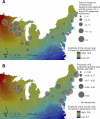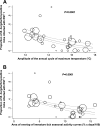Climate and tick seasonality are predictors of Borrelia burgdorferi genotype distribution
- PMID: 19251900
- PMCID: PMC2675205
- DOI: 10.1128/AEM.02633-08
Climate and tick seasonality are predictors of Borrelia burgdorferi genotype distribution
Abstract
The blacklegged tick, Ixodes scapularis, is of significant public health importance as a vector of Borrelia burgdorferi, the agent of Lyme borreliosis. The timing of seasonal activity of each immature I. scapularis life stage relative to the next is critical for the maintenance of B. burgdorferi because larvae must feed after an infected nymph to efficiently acquire the infection from reservoir hosts. Recent studies have shown that some strains of B. burgdorferi do not persist in the primary reservoir host for more than a few weeks, thereby shortening the window of opportunity between nymphal and larval feeding that sustains their enzootic maintenance. We tested the hypothesis that climate is predictive of geographic variation in the seasonal activity of I. scapularis, which in turn differentially influences the distribution of B. burgdorferi genotypes within the geographic range of I. scapularis. We analyzed the relationships between climate, seasonal activity of I. scapularis, and B. burgdorferi genotype frequency in 30 geographically diverse sites in the northeastern and midwestern United States. We found that the magnitude of the difference between summer and winter daily temperature maximums was positively correlated with the degree of seasonal synchrony of the two immature stages of I. scapularis. Genotyping revealed an enrichment of 16S-23S rRNA intergenic spacer restriction fragment length polymorphism sequence type 1 strains relative to others at sites with lower seasonal synchrony. We conclude that climate-associated variability in the timing of I. scapularis host seeking contributes to geographic heterogeneities in the frequencies of B. burgdorferi genotypes, with potential consequences for Lyme borreliosis morbidity.
Figures




References
-
- Achtman, M. 1995. Global epidemiology of meningococcal disease, p. 159-175. In K. Cartwright (ed.), Meningococcal disease. John Wiley & Sons, Ltd., Chichester, England.
-
- Anderson, J. F., and L. A. Magnarelli. 2008. Biology of ticks. Infect. Dis. Clin. N. Am. 22:195-215. - PubMed
-
- Barbour, A. G., and D. Fish. 1993. The biological and social phenomenon of Lyme disease. Science 260:1610-1616. - PubMed
-
- Belozerov, V. N. 1982. Diapause and biological rhythms in ticks, p. 469-500. In F. D. Obenchain and R. Galun (ed.), Physiology of ticks. Pergamon Press, Oxford, United Kingdom.
Publication types
MeSH terms
Grants and funding
LinkOut - more resources
Full Text Sources

